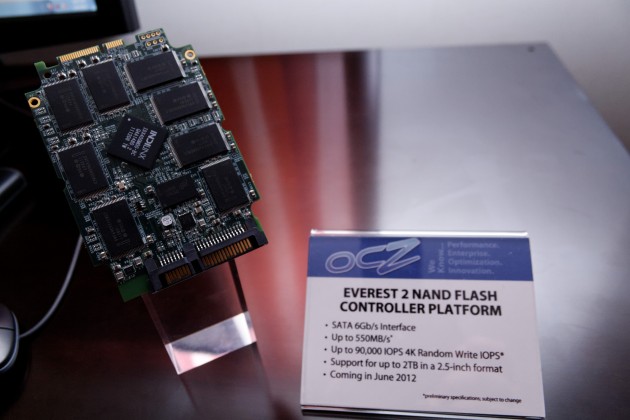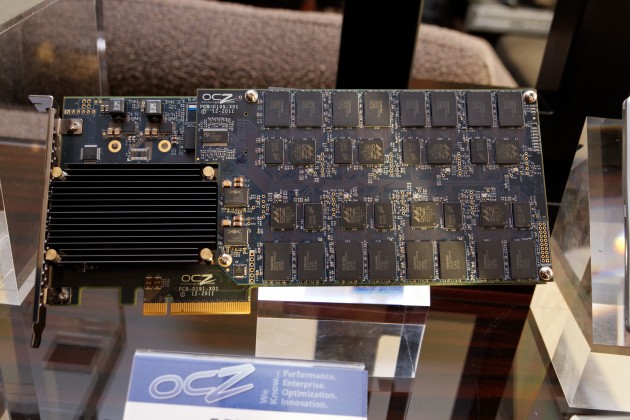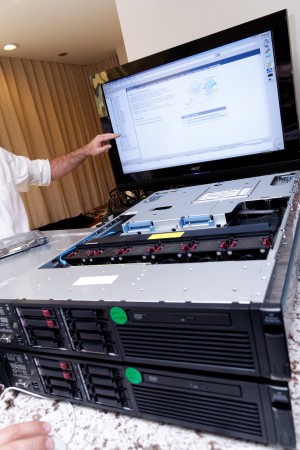This year OCZ Technology had several new products to show off as well as their first significant acquisition announcement of the year.

Tastes good!
The Z-Drive R5 is the first product built on the Kilimanjaro platform, a product born from a collaboration between OCZ and Marvell. It’s the world’s first PCIe x16 Gen 3 SSD, supporting capacities up to 12TB, a blistering 16GB/s and up to 2.52 million IOPS. The Z-Drive R5 comes in a range of form factors: full-height, half-height, and 2.5″ PCIe. Optional power fail protection is also available. Oh, and it tastes great too!
The Indilinx Everest 2 controller is designed specifically for I/O intensive workloads at speeds of up to 550MB/s, and up to 105K random read and 90K random write IOPS. Drive capacities of up to 2TB are supported in a 2.5″ form factor. Everest controllers will be among the first to offer triple-level cell (TLC) NAND flash, allowing a 30% lower cost than traditional MLC SSDs enabling the introduction of SSDs into markets previously considered to be price sensitive. Everest 2 launches in June 2012.
The Z-Drive R4 CloudServ RM1616 places up to an astounding 16TB of storage on a single PCIe card. Speeds of up to 6.5GB/s and over 1.4 million IOPS are possible with this SSD. Its concentrated performance and capacity enables system architects to design more productive infrastructures while lowering costs associated with hard drive technology.
Chiron is an SSD designed for the enterprise. The Indilinx-based controller and flash are actually capable of exceeding SATA III speeds, but for now they deliver transfer rates in excess of 560MB/s. Capacities are available up to 4TB in a 3.5″ package.
OCZ in the enterprise
While not yet close to abandoning the consumer market, it is very clear that OCZ is moving into the enterprise space. Days ago, they announced the purchase of SANRAD, a privately held provider of flash caching and virtualization software and hardware. Its virtualization software and solutions are VMware, Microsoft, and Citrix certified and are expected to accelerate the adoption of OCZ’s PCIe-based flash storage solutions in virtualized environments.
The SANRAD team demonstrated its capabilities using a server setup with two sets of eight virtual machines—one “normal” set with only mechanical disk (mind you, a fibre channel, high performance mechanical system) access, the other set using a bank of the aforementioned Z-Drive R4 CloudServ RM1616 SSDs.
Using SANRAD’s system, the accelerated VM set booted in a matter of seconds, while the disk-only set chugged along for several minutes afterward. To further drive the point home, a performance monitor was enabled on the non-cached bank of VMs. Once the baseline storage performance for the VMs was established (somewhere around 45 MB/s), SSD caching was enabled. Almost immediately performance started improving, and within a few minutes speeds in excess of 500MB/s, well over ten times the throughput of a standard disk-based array.
The SANRAD software caches VM data intelligently to the Z-drives, using their proprietary algorithm. One of the killer features that is unique to this OCZ system is the fact that VMs can be moved to different physical servers, even while the cache remains on the original Z-drive it was written to. This means only one of the servers in your VM cluster needs to have the Z-drive in it and all of the servers will cache to it using an iSCSI link. We watched in real time as the tester moved 8 VMs to a different server, while the performance merely “blipped” for a moment, it came right back up to the 500mb/s level it had been running at.
The demo was basically jaw-dropping, which is a rare occurrence at CES. OCZ continues to make smart acquisitions that show they are clearly positioning themselves to be a future leader in enterprise storage.


















 Articles RSS
Articles RSS